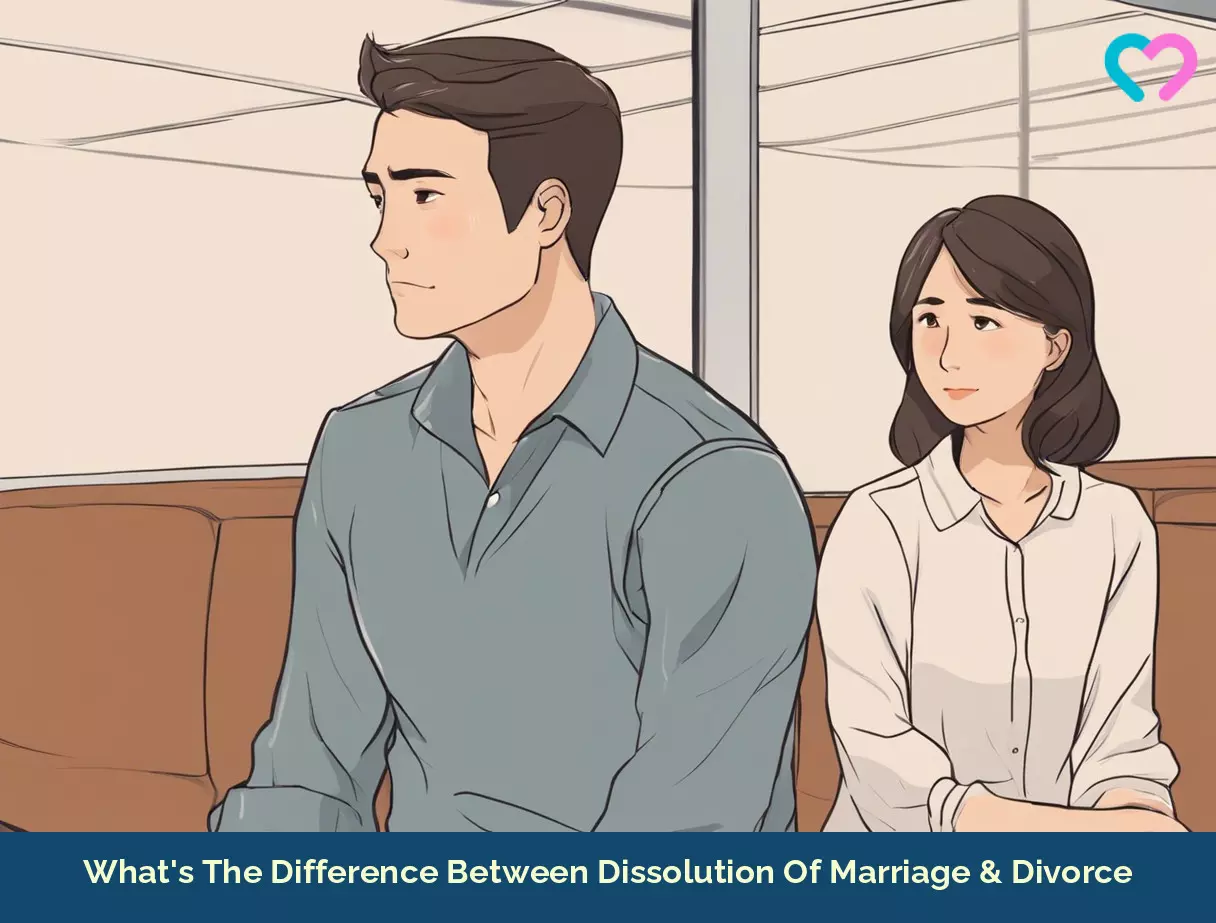

Image: Shutterstock
The ordeal of the termination of a relationship is never easy, but it should not necessarily have to be with a conflict or argument. Dissolution of marriage can be your option to break up on mutual terms with the legal proceedings and protocols. The process is an official settlement for ending a marriage so that both parties can split and part ways peacefully. If you are in that part of your life where you seek support for ending your marriage, this post can help you with the common procedure that needs to be followed for the disintegration of marriage in the US.
What Is Dissolution Of Marriage?
Dissolution of marriage is the legal procedure to end a marriage or parting officially. In dissolution, both the parties come to a mutual agreement on the division of marital property, spousal support, parental rights, and child support. So, there is no space for accusations, disengagement, and counter-accusations.
You can file for the dissolution of marriage on the grounds that fall within the legal framework of the state legislature.
Is The Dissolution of marriage different from divorce?
They are used synonymously. Both dissolution and divorce are the legal ways to end a marriage and are used interchangeably. However, in a dissolution of marriage, both the parties come to a mutual agreement regarding the distribution of property, child custody, alimony, etc., and the court passes the decree without any further trials. In some cases the marriage is long over between couples before they legally dissolve it. This happens when a couple gets emotionally detached from each other. Blogger Anne DaShiell says, “When I went through a divorce in 2002, my husband had emotionally dissolved our marriage long before he mentioned anything to me. We each spoke to our officiant over the phone; his advice to me was to let my marriage go — there was no hope for recovery because my husband’s heart was hard, his mind was clouded, and his ears were closed. Two months earlier, I had pointed out that our marriage needed help; however, he felt no desire to do anything to seek help for us (i).” On the other hand, divorce happens when the parties have a disagreement and decide to fight it out in court for disunion. The court intervenes and settles the disputes and disunity in a series of trials.
What Are The Grounds For Dissolution Of Marriage?
In the US, each state has its own set of grounds. The below flowchart covers the most common grounds for dissolution of marriage, followed by a detailed explanation:
* They are not the grounds but the type of marriage that the couple might have entered.
1. Grounds for no-fault dissolution of marriage
In this type, both the partners file a petition of mutual agreement to separate without the need to prove the fault of their spouse. The most common ground in the case of no-fault dissolution is “irreparable breakdown of marriage” or “irreconcilable differences”.
After both partners have agreed and signed the petition for this type of disaffiliation, they cannot object to the other party’s plea for dissolution. In this type of dissolution, the couple needs to stay apart for a certain period of time before filing the petition.
In the US, a few states accept only the no-fault grounds. Next, we will tell you about the various aspects of such a dissolution of a relationship.
I. The true no-fault states: 17 US states grant the dissolution on the no-fault grounds only. This means the divorce is granted on the basis of “irreconcilable differences” between the couple. The court does not allow casting faults as a ground for the dissolution of marriage. However, if there are faults, they could be considered as a factor at the time of granting child custody, dividing the property, providing alimony, etc.
The true no-fault states are Wisconsin, Kentucky, Washington, Oregon, Nevada, Nebraska, Montana, Missouri, Minnesota, Michigan, Kansas, Iowa, Indiana, Hawaii, Florida, Colorado, and California.
The below table covers the basic features of a true no-fault dissolution in each state:
| State | Residency requirement | Property division | Do-it-yourself dissolution |
|---|---|---|---|
| Oregon (1) | Six months or 180 days before filing for dissolution |
| Yes |
| Nevada (2) (3) | At least six weeks | Community property: Any income or property earned by the couple during their marriage is community property and is divided equally. | Yes |
| Nebraska (4) (5) | One year | Equitable division | Yes |
| Montana (6) (7) (8) | 90 days | Equitable division | Yes |
| Minnesota (9) | Six months or 180 days | Equitable division | |
| Hawaii (10) (11) | Six months | Equitable division | Yes |
| Colorado (12) (13) | 3 months or 90 days | Equitable division | Yes |
| Wisconsin (14) (15) | 30 days | Community property division | Yes |
| Kentucky (16) | 180 days | Equitable distribution | Yes |
| Washington (17) | 90 days | Community property distribution | Yes |
| Missouri (18) | 90 days | Equitable distribution | Yes |
| Michigan (19) | 1 year | Equitable distribution | Yes |
| Iowa (20) (21) | 1 year | Equitable distribution | Yes |
Child custody and support in the true no-fault states:
The court usually looks for joint custody. Where that is not possible, it will consider factors such as emotional ties, interest, desirability, and absence of abusive behavior while deciding the custody. The individual income levels are also a deciding factor.
II. Exceptions among the true no-fault states
A few states among the true no-fault states accept “incurable insanity” as a ground for dissolution of the partnership, along with “irreconcilable differences”. If the spouse is insane and mentally incompetent for some time, and the doctors have confirmed that there is no chance of recovery, or if the partner fails to perform marital duties, then the court will accept the dissolution of marriage. Those states include:
| State | Residency requirement | Property division | Do it yourself dissolution |
|---|---|---|---|
| California (22) | 6 months | Community property distribution | Yes |
| Florida (23) | 6 months | Equitable distribution | Yes |
| Kansas (24) | 60 days | Equitable distribution | Yes |
| Indiana (25) | 6 months | Equitable distribution | Yes |
| North Carolina (26) | 6 months | Equitable distribution | Yes |
Process For Dissolution Of Marriage Under No-Fault Grounds
- Both the partners must come to a mutual agreement that they are intending to dissolve the marriage due to irrevocable differences.
- Each state in the US has specific requirements when it comes to the residency, property settlements and child support, check what is applicable to you.
- Come to a mutual agreement on all the aspects of the dissolution, such as the distribution of marital property, child support and custody, and alimony.
- The official divorce forms can be obtained from the court clerk, online or from your local library.
- Fill in the forms and submit them, along with the necessary proofs, at the court clerk’s office. You may have to pay a filing fee.
- The spouse must be notified, and a proof of that must be attached.
- Unless there are any objections or obstacles, there will be one hearing, and the judge will ask for any additional information needed.
- After the waiting period, the judge will sign a certificate officially dissolving the marriage.
2. Grounds For Fault Dissolution Of Marriage
In this type, there is no agreement between the couple. One of the partners initiates the divorce by stating one or multiple grounds for the dissolution and dissociation. In such cases, the court will tell the defendant to counter.
The marriage cannot be dissolved and is now termed as a divorce, wherein both the parties have to hire lawyers and proceed to trial until the court grants divorce as well as decides on the property distribution and child custody rights. Fault dissolutions do not require the partners to live apart for a specific period of time.
The usual grounds for a fault dissolution of marriage are:
- Adultery
- Voluntary abandonment for a certain period of time
- When one of the partners is facing life imprisonment in any state for a period of more than one year and has a minimum sentence of seven years
- The commission of a crime against nature or a beast either before or during the marriage
- Getting into addictions such as alcohol, narcotics, etc., after marriage
- Confinement of the partner to an asylum and is declared incurable at the time of filing the petition.
- If the wife gets pregnant during their marriage without the husband’s knowledge
- In the case of violent, cruel and inhuman treatment
The rest of the states except the true no-fault states accept both fault and no-fault grounds for dissolution of marriage. However, as mentioned in the previous section, the five states from the no-fault category accept only insanity as the ground.
Covenant and non-covenant marriages
In states like Arizona, Louisiana, and Arkansas there is an option to choose from the covenant and non-covenant marriages. The main differences between these two are:
- In a covenant marriage, the couple needs to seek pre-marital counseling as well as counseling before filing for dissolution.
 Experts say
Experts say- The grounds for filing dissolution in a covenant marriage are fewer when compared to non-covenant marriage.
- Irrevocable differences is not an adequate reason for seeking the dissolution of a covenant marriage.
- The couple has to stay apart for two years prior to the filing of dissolution and one year apart after the decree of legal separation.
Process For Dissolution Of Marriage Under Fault Grounds
In this type of disjoining and disbandment, the partner chooses to cast a fault, such as adultery, abandonment, a felony, imprisonment, etc., on the other partner for the failure of the marriage.
- Both parties need to hire legal help to represent them in court.
- As per the reason quoted for the dissolution of marriage, the judge might ask for additional proofs to substantiate the accusations.
- The defendant spouse is notified through a legal notice, and they need to attend the court hearings.
- There would be multiple hearings until the court is convinced that the fault stated for the dissolution is true.
- The division of assets, alimony and child custody will be decided by the court.
Do You Need A Lawyer For Dissolution Of Marriage?
Not necessary. You can proceed with a do-it-yourself dissolution of marriage if your case meets the following criteria.
- Both the parties have opted for a no-fault ground for the dissolution.
- Both you and your partner have come to a mutual agreement about the assets division, child custody, spousal support, etc.
- Your marriage is a non-covenant marriage.
- You have adequate information about your family’s assets and debts.
- You have the time and patience to acquire all the papers, fill the forms and file them.
- You have hired a professional mediator to deal with one or two minor issues that are blocking the dissolution.
You may hire a lawyer if your divorce is based on any of the fault grounds as you need someone to represent you in the court to prove your allegations. Also, consider hiring a lawyer if you are emotionally unstable or not sure of the procedure.
 Research finds
Research findsWhat Is A Certificate Of Dissolution Of Marriage?
It is an official court decree or order that states a particular marriage is no longer valid. In many states, the court signs an official order for dissolution of marriage. It contains the details of marital property distribution and the date of dissolution.
This certificate is needed for various post-divorce activities such as updating insurance policies, changing bank account names, etc.
How Long Will It Take To Get a Dissolution decree?
It might take six weeks to 12 months in the case of a no-fault or uncontested dissolution of marriage and nine months to one year in the case of a faults or contested dissolution of marriage.
Various factors can influence the time taken to get the final order. Some of them are:
- The nature of the dissolution — whether it is contested or uncontested and covenant or non-covenant.
- The value of the assets that need to be distributed between the parties.
- If the state has some legal separation or waiting period before and after the divorce.
- If there is any prenuptial agreement in place.
- The waiting period the judge legally takes to sign the legal decree.
Irrespective of the nature of dissolution, mutual cooperation, and readiness to clear all the legal requirements by both the parties can help in speeding up the process.
Frequently Asked Questions
1. Can marriage be dissolved without divorce?
No. Dissolution is a no-fault divorce. A marriage can only be dissolved by contested or mutual divorce. The dissolution petition is filed in court when both spouses agree on all the legal issues that need to be addressed.
2. Is a dissolution faster than a divorce?
Yes. The dissolution process is faster than a divorce because the couple agrees to divide their assets and raise their children. Moreover, it is more cost-effective than divorce.
3. What is the quickest dissolution of marriage?
The quickest dissolution of marriage depends on the laws and procedures of the jurisdiction where you are opting for a dissolution. You must file a divorce petition for it. To learn more about it, visit the website of your State court.
4. Can a dissolution of marriage be reversed or modified?
If your dissolution has been finalized and the court has issued a divorce decree, it becomes legally binding. It terminates your legally recognized and binding marriage. However, visit the website of your State’s court to learn the specifications of reversing or modifying the dissolution of marriage in your State of residence.
5. How can I prepare for a dissolution of marriage?
While preparing for the dissolution process, reflect on your future. You must answer certain critical questions, such as if you will be keeping the house and how you will be paying for it. During this time, identify and spend time with your support system. You must also get all your financial documentation and supporting personal documents ready for the dissolution process.
6. What are the potential financial consequences of a dissolution of marriage?
The financial consequences of a marriage dissolution involve the division of your possessions and assets. Apart from your money, the debt you acquired during the marriage is divided between the partners. Marital debts like a mortgage on your home, home equity loans, student loans, credit cards, and automobile loans constitute other financial implications.
7. How is spousal support determined during the dissolution of marriage?
Various factors are considered by courts when determining spousal support. The earning capacity of the recipient spouse, money earned by each spouse, and sources of funds like savings accounts are key factors that determine spousal support.
Marriage is not always a bed of roses. While some go through trials and tribulations, it may be a lot to take for others. Both situations are okay as long as both the partners are happy and content. Dissolution of marriage is based upon mutual agreement and understanding, which involves a series of paperwork and procedures. Each US state may have different requirements and rules for the same. So do understand your state’s laws regarding the dissolution of marriage before proceeding, and do not hesitate to seek support from your loved ones during this time.
Infographic: When Does A Marriage Dissolution Not Require A Lawyer?
You are likely to consider consulting a lawyer by default when it is a matter dealing with law, especially involving marriage. However, if you have opted for the dissolution of a marriage, in that case, there are certain criteria and situations, as presented in the infographic below, that do not necessitate the involvement of a lawyer.
Illustration: Momjunction Design Team
Key Pointers
- Dissolution of marriage is the legal procedure to end a marriage with a mutual agreement.
- The mutual agreement regarding the distribution of property, child custody, and alimony makes it different from a divorce.
- You may or may not require a lawyer, and each state in the US has specific requirements for residency, property settlements, and child support.
Illustration: What&039s The Difference Between Dissolution Of Marriage & Divorce
Image: Stable Diffusion/MomJunction Design Team
The best way to end a marriage in Ohio is through dissolution. But you must consider council to proceed effectively. Watch this video and familiarise yourself with the process.
Personal Experience: Source
MomJunction articles include first-hand experiences to provide you with better insights through real-life narratives. Here are the sources of personal accounts referenced in this article.
i. Dissolution;https://medium.com/@annedashiell/dissolution-9f30346e1e50
References
1. Forms for dissolution and dissolution of registered domestic partnership; Oregon Judicial Branch
2. Custody Paternity and Child Support; Supreme court of Nevada
3. Divorce Forms; State Of Nevada self help center
4. Nebraska Divorce FAQ: Divorce in NE; Cordell & Cordell
5. Enforcement of Alimony or Property Settlement Orders; Nebraska Judicial Branch
6. Child Custody, Parenting Plans, Visitations; Montana Judicial Branch
7. Child Support; Montana Judicial Branch
8. Divorce, Dissolution, Legal Separation, Annulment; Montana Judicial Branch
9. Minnesota’s Child Support Laws; Minnesota House Of Representatives
10. Child Support Guidelines; Hawaii State Judiciary
11. Divorce forms; Hawaii State Judiciary
12. Divorce in Colorado;Colorado Legal Services
13. Colorado Divorce; WomensLaw.org
14. Custody and Placement: Answering Your Legal Questions; State Bar Of Wisconsin
15. Basic Guidelines for Divorce/ Legal Separation; Wisconsin Courts
16. Divorce in Kentucky ; kyjustice.org
17. Divorce/Separation; ; WashingtonLawHelp.org
18. Divorce; Missouri Legal Services
19. Divorce; Michigan Legal Help
20. Court Forms; Iowa Judicial Branch
21. Representing Yourself;
22. Divorce in California; California Courts
23. Filing For Divorce Without An Attorney; State of Florida
24. Divorce; Kansas Judicial Council
25. Divorce Forms; Coalition for court access
26. Separation and Divorce; North Carolina Judicial Branch
27. Developmental Patterns in Marital Satisfaction: Another Look at Covenant Marriage; National Library of Medicine.
28. The U.S. Divorce Rate Has Hit a 50-Year Low; Institute for Family Studies.
Community Experiences
Join the conversation and become a part of our nurturing community! Share your stories, experiences, and insights to connect with fellow parents.
Read full bio of David M. Gross
Read full bio of sanjana lagudu
Read full bio of Shikha Thakur
Read full bio of Ratika Pai
























